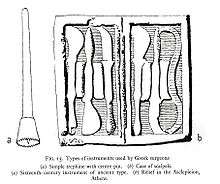Trephine


A trephine (/trᵻˈfaɪn/; from Greek trypanon, meaning an instrument for boring)[2] is a surgical instrument with a cylindrical blade. It can be of one of several dimensions and designs depending on what it is going to be used for. They may be specially designed for obtaining a cylindrically shaped core of bone that can be used for tests and bone studies, cutting holes in bones (i.e., the skull) or for cutting out a round piece of the cornea for eye surgery.
A cylindrically shaped core of bone (or bone biopsy) obtained with a bone marrow trephine is usually examined in the histopathology department of a hospital under a microscope. It shows the pattern and cellularity of the bone marrow as it lay in the bone and is a useful diagnostic tool in certain circumstances such as bone marrow cancer and leukemia.
See also
References
- ↑ Holmes, Oliver Wendell (September 18, 2008). Medical Essays.
- ↑ τρύπανον. Liddell, Henry George; Scott, Robert; A Greek–English Lexicon at the Perseus Project.
External links
-
 "Trepan". The American Cyclopædia. 1879.
"Trepan". The American Cyclopædia. 1879.